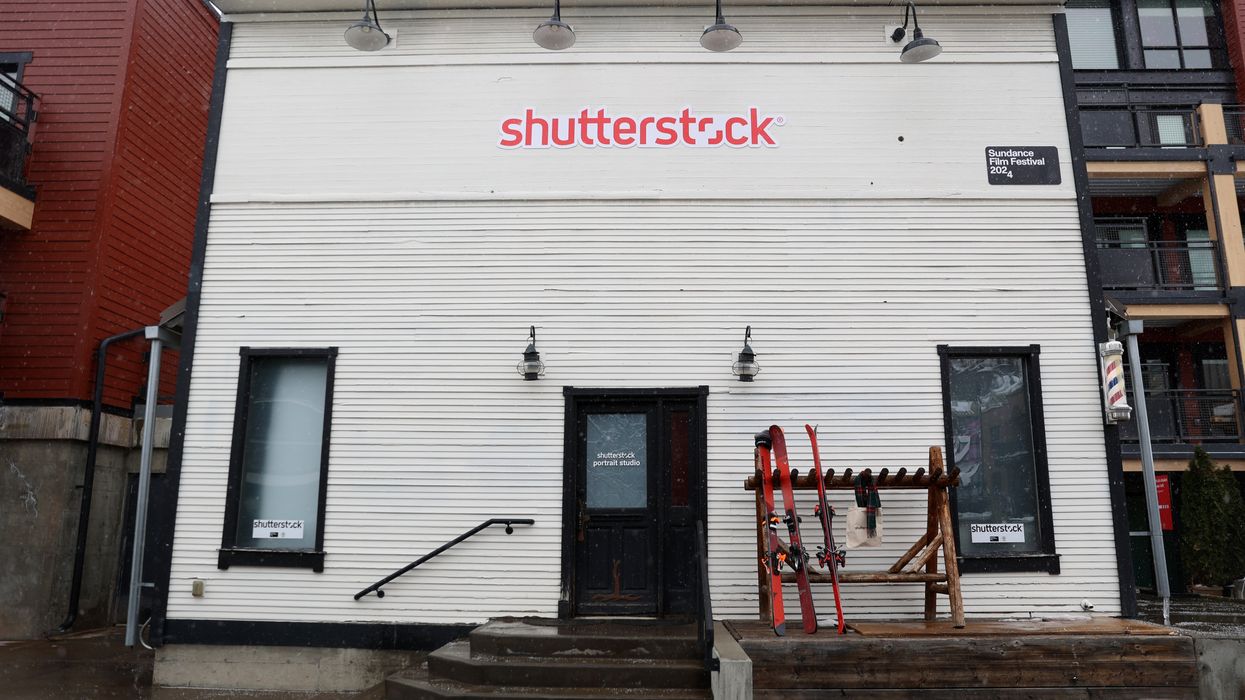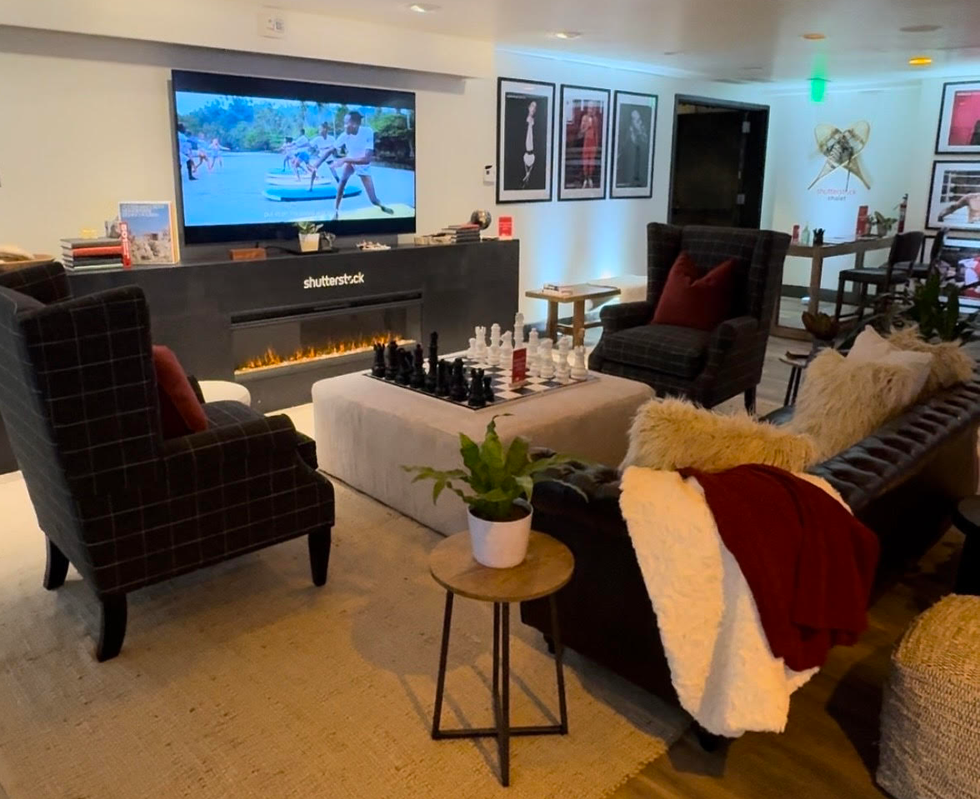The Shutterstock Resources Filmmakers Should Know About
It's more than a stock photography outlet.

The Shutterstock Chalet at Sundance 2024
It's a name you probably already know well, as an editorial house with vast resources for designers, creators, and filmmakers.
But Shutterstock is more than that. This year at The Sundance Film Festival, it's serving as the official house photographer and portrait studio partner of the festival. If you were on the ground at the fest, you might have run into the 50 photographers, videographers, editors, and production staff onsite.
Shutterstock also brought a short documentary to the festival, which screened at its chalet activation. The doc is called Surfing Through the Odds and features young African women, the first Black female surfers to be featured in a photo and video collection.
To learn more about how Shutterstock is supporting indie film and opportunities for creators, No Film School spoke with members of the Shutterstock team, including Adam Barnett, Senior Director of Production for Shutterstock Studios, EMEA, and APAC, and Aiden Darné, VP of Shutterstock Studios.
'Surfing Through the Odds'

Surfing Through the Odds at the Shutterstock Chalet
Courtesy of Shutterstock
Barnett spoke to how the partnership for Surfing Through the Odds came about.
"It started off with a client working with the NGO, Soma, and trying to find content of Black girls surfing, and through various different stock platforms, could not find any good images," Barnett said. "So huge content gap, and Shutterstock Studios then became a very unique partner in two ways. One, the ability to help tell a story of SOMA in São Tomé, [a] tiny little island just off the coast of Africa. But secondly, we were looking at a way of creating not just awareness through the documentary, but more of a sustainable shelf life for SOMA as an NGO. And one of the ways of doing that was making them the contributing partner, creating a massive suite of assets that we could take when we were out shooting the documentary, and putting them on our platform for the world to be able to license.
"And the benefit of that is that every image licensed, portions of the money generated goes to the contributor, who are SOMA. So they get rewarded... hopefully, the more sustainable they become, and revenue they generate to keep it growing and keep building what they've been doing on the good work out in São Tomé."
Darné mentioned that this is not the first partnership Shutterstock has put together. They also created a six-part series for Carvana around a racing car driver, Jimmie Johnson, which was on NBC Sports.
"So we were kind of traditional global production studio that sits within Shutterstock," Darné said.
Shutterstock's Opportunities for Filmmakers

Main Street, Park City
Courtesy of Sundance Institute
Both Darné and Barnett pointed out that working with brands can provide a unique funding opportunity for filmmakers.
"I think the beauty of us as a business and the fact that we're global in our nature, we welcome working with new filmmakers all the time," Barnett said. "We rely on having a huge network of people to be able to produce content globally. We are not shooed into that kind of very old traditional model of having rostered people that you only work with.
"Even with SOMA, a great case in point, we ended up working with a fantastic female South African filmmaker who, through extensive research and looking for independent filmmakers that would be able to tell the story from an outsider looking in, was hugely important. So I think we can give lots of people a platform to be able to work in this space. I think the other beauty of what we do, Aiden mentioned about the brand side of things, is traditional funding of content is becoming increasingly more difficult either from the studio side."
Shutterstock Studios, they said, is in the business of short-form content and advertising as well as long-form.
Barnett said: "In fact, after we did our screening, there was a young Indian lady that came up to me and said, 'I'm a photographer and I shoot in London, but I also shoot in India. I'd be really interested to have a separate chat about what I can do if you have challenges shooting in India, for example.' So just by that, we get connected to people in a really organic way, and they always become part of our roster of people we want to try and work with."
We had discussed Jane Schoenbrun's film, I Saw the TV Glow, and Darné pointed out Shutterstock was among the credits for that project.
"We're incredibly proud of the network, the global network that we have of either established documentary filmmakers, commercial directors, all the way down to more up-and-coming," Darné said. "Yeah, we're always hungry to expand the network in that community. We've got a team in APAC that does that same thing, in India and North America and Latin America, so it's [a] great global footprint as well.
"So yeah, I know that's a strange crappy thing to say, 'Get in touch,' but it is about broadening the network and ensuring that your work is being shared and seen, and particularly with all of the new workflows that help enable filmmaking to be faster and more affordable, generative one of those tools, I think it's an opportunity for lots of people to try and get their work seen in a way that wasn't possible before."
How Shutterstock Approaches New Technology

The Shutterstock Chalet
Courtesy of Shutterstock
It seemed inevitable that it would come up, but we also touched on virtual production, 3D modeling through Shutterstock's acquisition of Turbosquid, and generative AI.
Despite AI being unexplored territory, Shutterstock partnered early on with Nvidia, Amazon, Meta, Google, and LG, Darné said. They also looked at their existing library as a resource.
Darné said: "The interesting part for us to play within the whole generative ecosystem is we obviously have nearly a billion images with incredibly deep metadata tagging on every image, almost in some cases over 140 bits of metadata. So we've been able to not just be on the periphery, we've been helping build the models with all the data that we have. So it's quite a strange position in that we were obviously seeing the risk with generative to the core business, but the upside is we've been able to monetize the data part of it."
This means that Shutterstock doesn't run into the sticky territory of scraping data at large, and creators get paid for their data.
Barnett added: "We're using a data set of content that we own, which means the machine learning and the creation of that is using data that can be commercially licensed. So there's some fantastic platforms and tools out there to create content. Most of that is scraped from the internet. Whereas anyone who is creating [and] using our generative model on the platform ultimately is able to then utilize and license that image to use commercially, which again is a fairly unique offering."
What about virtual production?
"We talk a lot about sustainability; virtual production becomes a more sustainable way of producing as well," Barnett said. "So I think that will be one of the things to watch out for this year. We see it a lot at the moment in film, and we'll see a lot more of that change. We're doing it already. We've already created three or four commercials for fairly big global brands using virtual production. You'll see a huge shift of that, I think, this year in terms of ways in which content is produced."
Last year, Shutterstock also acquired GIPHY, which I'm sure we all know about if we've spent any time online. It's a massive platform for creating and sharing GIF images.
"So what we can do is work with large Hollywood studios, and we can go and, of course, through editorial shoot the red carpet event," Darné said. "Studios can produce an immersive type activation or experience off the back of it. And through the GIPHY platform, we can have two or three weeks of a media flight of content that's going to be promoting the film that we're going to do. So it's this really weird, quite interesting flywheel of things that we can do. It's quite unique."

No Film School's coverage of Sundance 2024 is brought to you by Canon.
- The Lenses Of Sundance 2024 Show That Filmmakers Love Variety ›
- What Sold at Sundance 2024? ›
- How Will Shutterstock Selling AI-Generated Art Affect You? ›
- Sundance Recap ›











